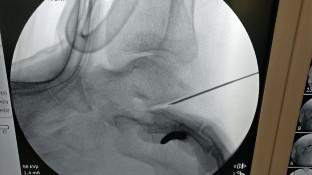Indian Journal of Orthopaedics ( IF 1.1 ) Pub Date : 2022-08-09 , DOI: 10.1007/s43465-022-00707-3 Nitesh Gahlot 1 , Kishor Kunal 1 , Abhay Elhence 1

|
Introduction
Posterior arthroscopic subtalar joint arthrodesis (PASTA) via a posterior 2-portal technique has been described. We modified the surgical technique of creating the portals in the plane of the posterior facet (under fluoroscopy guidance) to enhance the ease of access to the joint, easier and complete removal of articular cartilage along with maintaining the heel height.
Methods
Patients of post-traumatic subtalar joint arthritis, treated by PASTA during 2016 till 2019 were included in the study. Exclusion criteria: significant height collapse of calcaneum, lateral blow out or heel widening. The confirmation of subtalar joint as the source of pain was done by injection of local anaesthetic inside the joint under the image intensifier, bringing immediate pain relief. The primary outcome variables assessed were the pain and functional scores, assessed using visual analogue scale and AOFAS (American Orthopaedic Foot and Ankle Society) score, respectively.
Results
The total of 16 patients (7 males, 9 females) was included. The average age was 40.68 years (23–58 years). The underlying pathology in all patients was post-traumatic subtalar arthritis secondary to calcaneus fracture malunion in 8 patients (50%), talus fracture malunion in 4 (25%) and ligament injury in 2 patients (12.5%). No bone grafting was done. The mean duration of follow-up was 15.6 months (9–24 months). There was a statistically significant improvement (p < 0.001) in mean VAS score at follow up (2; range 0–4) as compared to the mean preoperative score (7; range 6–9). The AOFAS score also improved significantly (p < 0.001) at the follow up (mean 79; range 68–89) as compared to the preoperative score (mean 18; range 10–25).
Conclusion
The posterior arthroscopic fusion of subtalar joint gives good results in terms of pain relief and functional scores when done for carefully selected patients of subtalar joint arthritis. Our slight modification of the original technique improves the ease of removing cartilage from subtalar joint with minimal height loss; thus, precluding any need for bone graft. It also makes the instrument movement easier inside the joint.
中文翻译:

关节镜下距下关节融合术的改良后 2 入口技术:平均 15 个月随访时疼痛和功能结果得到改善 - 病例系列
介绍
已经描述了通过后 2 门技术的后关节镜距下关节融合术 (PASTA)。我们修改了在后关节面平面上创建入口的手术技术(在透视引导下),以提高进入关节的便利性,更容易和完全去除关节软骨,同时保持脚跟高度。
方法
该研究纳入了2016年至2019年期间接受PASTA治疗的创伤后距下关节关节炎患者。排除标准:跟骨高度明显塌陷、外侧爆裂或脚后跟增宽。确认距下关节为疼痛源,在影像增强器下向关节内注射局麻药,立即缓解疼痛。评估的主要结果变量是疼痛和功能评分,分别使用视觉模拟量表和 AOFAS(美国骨科足踝协会)评分进行评估。
结果
共纳入16例患者(男7例,女9例)。平均年龄为 40.68 岁(23-58 岁)。所有患者的基本病理为继发于跟骨骨折畸形愈合(8 例(50%))的创伤后距下关节炎、4 例(25%)距骨骨折畸形愈合和 2 例(12.5%)韧带损伤。没有进行骨移植。平均随访时间为 15.6 个月(9-24 个月)。 与术前平均评分(7;范围 6-9)相比,随访时平均 VAS 评分(2;范围 0-4)有统计学显着改善(p < 0.001)。 与术前评分(平均 18;范围 10-25)相比,随访时AOFAS 评分(平均 79;范围 68-89)也显着改善(p < 0.001)。
结论
对于精心挑选的距下关节关节炎患者来说,后路关节镜下距下关节融合术在缓解疼痛和功能评分方面取得了良好的效果。我们对原始技术进行了轻微修改,提高了从距下关节去除软骨的容易性,同时高度损失最小;因此,排除了任何骨移植的需要。它还使器械在关节内移动更容易。











































 京公网安备 11010802027423号
京公网安备 11010802027423号